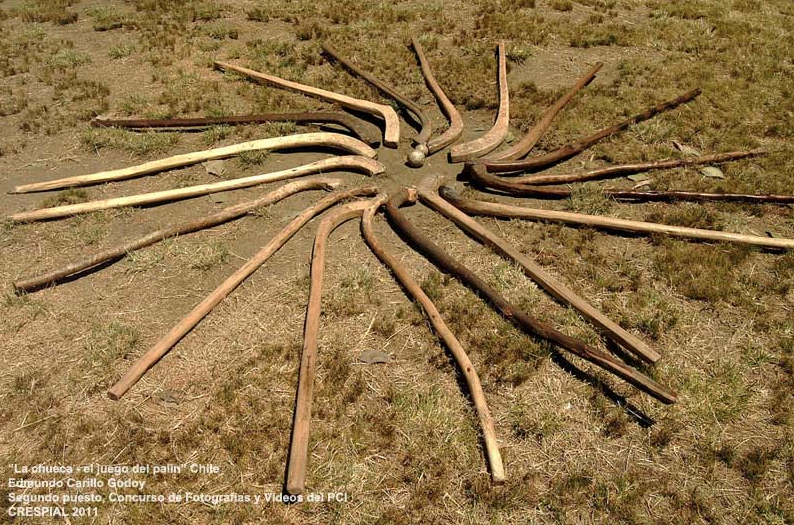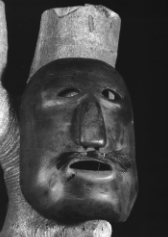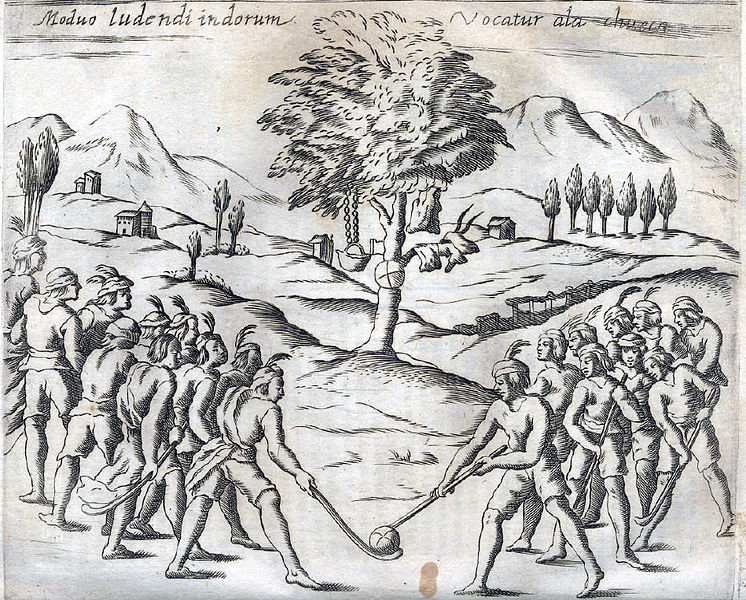PALIN - THE CHUECA
Palin - El Palin - The Chueca is a stick and ball game originating in southern Chile and southwestern Argentina by the Mapuche People. There is a ritual celebration accompanied by prayers, dances and feasting meant to fortify both individual and communal relationships. It can be played between two friendly communities or sometimes to settle differences between antagonistic tribes, thus avoiding the armed conflict.

Two teams representing their communities, each one with the same number of players, between 5 and 15, placed in two rows facing each other, on a rectangular field which is 200 meters long and 12 meters wide. Its size is variable according to the number of players and the available space. We must remember that the length is always greater than the width. The bounds are marked either by means of thin trenches or with tree branches or shrubs, or even sawdust.
Playing sticks are made from different woods, and raw beech is preferred because of its hardness and consistency. It should be bent at one end. They bend the wood by soaking it in water, or even using a simple but effective method which comprises subjecting the wood to a high pressure at one of its ends, with hot steam and then the keep hanging with ropes in this position for a number of days.

The ball has a diameter of 4.5 to 5 cm, and has a circumference of 16 centimeters. Its weight is about 50 grams. It can be made of various materials. Indeed, it can be crafted wool sheep leather covered extract the belly of the horse. It can also be made of wood, oak hazel or tree root. In any case, the result is the same, namely a extremely hard ball.
The ball is put into play at midfield / centre of the playing surface in a cavity or hole called a Dignilwe.
There is no particular uniform, although there is a particular use of clothing during a match. In fact, players roll up their pants to the level of knees, and when the weather is hot, they do not put anything on top of the belt, except trarilonko, headband made of sheep's wool that place, as its name indicates, at the front around the head (lonko). In addition, players do not wear footwear.
The team players are placed aligned next to each other facing the team that opposing it, is placed similarly. "It is interesting to note that among the stick and ball games, palin is the only place where players in lateral position with respect to the goal lines-lines or xipalwe [tripalwe] - and of course this is the position most correct to drive the ball with the stick.
During the game, players are divided into three categories: defensive, attacking and Central Africa. The dignilfe is the player who moves to the center. On the left, we find attackers (tripalfe) and his defenders right (kacilfe). Another important detail is the that the number of defenders is always equal to the attackers. Thus, each camp or team always has an odd number of players, because it is also the center or dignilfe.

Until the early twentieth century the Mapuche people also used masks called Kollon, for their protection against any blows.
The most important game in South America for its Aboriginal cultural content, geographical spread and survival. It's a game that has more than a thousand years of existence. This can be established through the remnants of their courts there.
The Mapuche people have never written rules for palin. At Chilean society Leotardo Matus wrote in 1920 Regulation of this practice in order to apply it to school education, but this book was ignored by the Mapuche people in time and forgotten by Chilean society with the arrival of Western sports.
The game of palin is today also present in the cities, especially played by Mapuche youngsters and students. For them, the game inherited from their forefathers constitutes a core element of their endangered identity.
In many Mapuche urban neighborhoods centers of native culture have been constructed mostly in the shape of traditional “ruka” – a thatched conical building for gatherings and ceremonies. A playfield is usually located close to such a center, which is used both for palin and football matches.
HISTORY
The game of Palin / Chueca belongs to the cultural tradition of the Mapuche People, the largest native minority group in Chile.

Extracted from Eduardo Galeano, Memoria del Fuego, I. Los Nacimientos.
In 1647, gambling is forbidden among aborigines in Santiago de Chile.
"The Captain General, don Martín de Mujica, proclaims the prohibition of the chueca, game practised by the Araucanians according to their tradition, by hitting a ball with sticks curved at one end in a field sorrounded by green branches.
Those who disobey will be punished with one hundred lashes and the others will be fined, because the vile "chueca" has been widely spread among Creole soldiers.
The edict of the Captain General dictates the prohibition "in order to avoid sins so much in against the honour of God Our Lord", and because the Indians train for war running after the ball. "Disorder arises from the game and then they shoot arrows amongst themselves".
It is indecent, he says, that for the chueca, men and women gather almost naked, "dressed only with feathers and animal furs, in which they base the chance to win". At the beginning, they invoke the Gods for the ball to be farourable to their prowesses and races , and finally, embraced, they drink chicha by the bucketful.
By Diego de Rosales, Historia General del Reino de Chile, Flandes Indiano. Written approximately between the years 1652 and 1673
"The most ordinary game is the Chueca... They hit a ball with some twisted sticks curved in one end... which have a natural curve at one end and is used as a mallet. They form two gangs to fight against each other to carry the ball, placed in the middle of a hole., to their own team until they take it out from the line, marked on both sides.... They get a poit when the ball goes through the line on their side. The game is over after six or four lines, and they can play a whole afternoon.
After the game, they sit down to drink chicha and get completely drunk. Sometimes during these meetings, they come to agreements for uprising, because they call for other Indiands from the whole Earth, and at night, they talk and agree on rebelions. Thus governors sometimes forbid this game and these meetings for the damages experienced.
In order to be comfortable while running, they play the game naked, wearing only a loincloth to cover their indecency. Women sometimes play this game, but they wear some cloth, and they all attend to the field to see them play and run."















